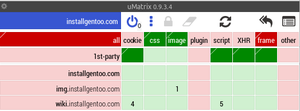We are still actively working on the spam issue.
Difference between revisions of "Chromium"
m (→Tracking Details) |
m |
||
| Line 11: | Line 11: | ||
== Google Chrome == | == Google Chrome == | ||
| − | [[File:Chrome.png|thumb|right|The Google Chrome | + | [[File:Chrome.png|thumb|right|The Google Chrome icon]] |
Google Chrome is a proprietary sister project of Chromium developed by Google. | Google Chrome is a proprietary sister project of Chromium developed by Google. | ||
| Line 17: | Line 17: | ||
In addition to Chromium's usual set of features, it packages Google's 'Pepper' Flash plug-in, a Foxit-based in-line PDF reader, an automatic updater, and several controversial tracking capabilities. Due to the latter, it is commonly accused of being a [[botnet]] by the more security-conscious participants on /g/, [[Welcome to the Botnet|'''for good reason''']]. | In addition to Chromium's usual set of features, it packages Google's 'Pepper' Flash plug-in, a Foxit-based in-line PDF reader, an automatic updater, and several controversial tracking capabilities. Due to the latter, it is commonly accused of being a [[botnet]] by the more security-conscious participants on /g/, [[Welcome to the Botnet|'''for good reason''']]. | ||
| − | === Official | + | === Official release channels === |
* Stable is targeted at most home and office users; | * Stable is targeted at most home and office users; | ||
| Line 41: | Line 41: | ||
Comodo Dragon is a proprietary fork of Chromium developed by Comodo. | Comodo Dragon is a proprietary fork of Chromium developed by Comodo. | ||
| − | |||
| − | |||
| − | |||
| − | |||
| − | |||
== Extensions == | == Extensions == | ||
| − | === Installing | + | === Installing extensions === |
Certain extensions demand that the user login to a Google account to install them from the Chrome Web Store, but a workaround exists. The major weakness of this workaround is that the extension cannot be automatically updated. If you are not willing to manually update the extension in question, your options are either living without it or switching to another browser. | Certain extensions demand that the user login to a Google account to install them from the Chrome Web Store, but a workaround exists. The major weakness of this workaround is that the extension cannot be automatically updated. If you are not willing to manually update the extension in question, your options are either living without it or switching to another browser. | ||
| Line 64: | Line 59: | ||
* Provided the everything went according to plan, we should have have a working extension. | * Provided the everything went according to plan, we should have have a working extension. | ||
| − | === Notable | + | === Notable extensions === |
''There seem to be many extensions for Chromium that claim to block advertisements. The one listed here is what /tech/ recommends.'' | ''There seem to be many extensions for Chromium that claim to block advertisements. The one listed here is what /tech/ recommends.'' | ||
| Line 104: | Line 99: | ||
For more details go [https://www.chromium.org/developers/design-documents/process-models here]. | For more details go [https://www.chromium.org/developers/design-documents/process-models here]. | ||
| − | ==== Suspending | + | ==== Suspending unneeded tabs ==== |
If you have tabs sitting around that you don't really actively need, you can unload them using [https://chrome.google.com/webstore/detail/the-great-suspender/klbibkeccnjlkjkiokjodocebajanakg The Great Suspender]. | If you have tabs sitting around that you don't really actively need, you can unload them using [https://chrome.google.com/webstore/detail/the-great-suspender/klbibkeccnjlkjkiokjodocebajanakg The Great Suspender]. | ||
| − | === Fixing | + | === Fixing touchscreen on Linux === |
If your device runs Linux and has a touchscreen, you probably noticed that, by default, Chrom* completely ignores touch events. To make Chrom* use your touchscreen, you first need to find your input device ID: | If your device runs Linux and has a touchscreen, you probably noticed that, by default, Chrom* completely ignores touch events. To make Chrom* use your touchscreen, you first need to find your input device ID: | ||
| Line 118: | Line 113: | ||
If ID of "Virtual core pointer" doesn't work, try the ID of touchscreen device. | If ID of "Virtual core pointer" doesn't work, try the ID of touchscreen device. | ||
| − | ===KDialog freezes | + | ===KDialog freezes=== |
| − | + | Launch with the following environment variable: | |
| − | + | ||
| + | {{ic|NO_CHROME_KDE_FILE_DIALOG=1 chromium}} | ||
== External links == | == External links == | ||
Revision as of 17:30, 2 April 2016
Chromium is a free and open source Web browser developed by Google and other contributors. It is known for its extremely fast JavaScript engine, multiprocess security model, and rapid development cycle.
When it was initially released, Chromium was vastly superior to the other major browsers in terms of performance, but this advantage gradually diminished in the years following its release as the other browsers caught up. Today, Chromium maintains an edge only in JavaScript performance and UI responsiveness.
Recently, Google forked the Apple-controlled Webkit project to give Chromium its own layout engine, Blink.
Google Chrome
Google Chrome is a proprietary sister project of Chromium developed by Google.
In addition to Chromium's usual set of features, it packages Google's 'Pepper' Flash plug-in, a Foxit-based in-line PDF reader, an automatic updater, and several controversial tracking capabilities. Due to the latter, it is commonly accused of being a botnet by the more security-conscious participants on /g/, for good reason.
Official release channels
- Stable is targeted at most home and office users;
- Beta;
- Dev;
- Canary is a bleeding-edge channel. Instability and vulnerabilities are to be expected.
Tracking details
Google Chrome's user tracking capabilities include, but are not necessarily limited to the following:
- Installation: upon installation, Google Chrome sends a randomly generated token from the installer back to Google. This is used to measure the success rate of Chrome installations. This feature is non-optional.
- RLZ identifier: an encoded string that, according to Google, contains non-identifying bits of information about where Chrome was downloaded from and when it was installed. It is transmitted to Google upon the first launch, first use of the address bar, and first Google search query. The collected information is used to measure the success of promotional campaigns. This feature is non-optional, but Google does provide the necessary source code to decode the string.
- ClientID: a unique identifier coupled with user preferences, logs of usages metrics, and crashes. This feature is optional and disabled by default.
- OmniBox predictions: any text typed into the address bar is sent to Google. This feature is optional, but enabled by default.
- Page-not-found web service: upon receiving a server not found response, the query typed into the address bar is sent to Google. This feature is optional, but enabled by default.
- Spell-checking web service: any text typed is transmitted to Google. This feature is optional and disabled by default.
- Google update: data concerning the user's Chrome usage, operating system details, and Chrome version is transmitted to Google periodically. This feature is non-optional.
Notable Forks
Comodo Dragon
Comodo Dragon is a proprietary fork of Chromium developed by Comodo.
Extensions
Installing extensions
Certain extensions demand that the user login to a Google account to install them from the Chrome Web Store, but a workaround exists. The major weakness of this workaround is that the extension cannot be automatically updated. If you are not willing to manually update the extension in question, your options are either living without it or switching to another browser.
- In this example, we will be using the Google Drive extension (https://chrome.google.com/webstore/detail/google-drive/apdfllckaahabafndbhieahigkjlhalf), but you can substitute it with any extension you prefer.
- Examine the URL of the extension that you wish to install and locate its ID. The ID is the apparent gibberish following the extension's name in the URL. In our example, it happens to be apdfllckaahabafndbhieahigkjlhalf.
- Once you have located the ID, insert it in place of the bracketed statement in the following URL.
- https://clients2.google.com/service/update2/crx?response=redirect&x=id%3D[Your ID Goes Here]%26uc
- In our example, the final URL is: https://clients2.google.com/service/update2/crx?response=redirect&x=id%3Dapdfllckaahabafndbhieahigkjlhalf%26uc
- Now that we have our URL, we must open it in a new tab and save the offered CRX file to a convenient location.
- Unfortunately, the file will not work for us as is, since we are not installing from the Chrome Web Store.
- To work around this problem, we must extract the contents of the CRX file to a folder with an archiver like 7zip.
- Once we have extracted the archive, we must enable 'developer mode' on our extensions page and load the folder as an unpacked extsion.
- Provided the everything went according to plan, we should have have a working extension.
Notable extensions
There seem to be many extensions for Chromium that claim to block advertisements. The one listed here is what /tech/ recommends.
- APNG - For those who want to seek enlightenment to the open source masterrace animated PNG. Good for when you go to the few corners of the web that actually use these things.
- Chromium Updater - This extension allows Windows and GNU/Linux users to conveniently identify, download, and install the latest Chromium build. It may not be as seamless or convenient as the automatic updates in Comodo Dragon and Google Chrome, but it does get the job done. Obviously, it should only be used with Chromium.
- EditThisCookie - Great cookie manager for Chromium.
HTTPS Everywhere is maintained by the Electronic Frontier Foundation. It forces supported sites to prefer secure connections. This does occasionally cause problems, so the option to enable or disable the extension on a per-site basis is included.
- PDF Viewer - This extension adds PDF.js, the free and open source HTML5 PDF reader found in Firefox, to Chromium.
- Stylish - This extension allows the user to apply custom visual styles to Websites, internal browser pages, and more.
- Tampermonkey - This extension adds a proper user script manager to Chromium. While it is certainly possible to install user scripts as Chromium extensions without this extension, it makes managing them much more convenient.
uBlock Origin is a lightweight and low-resource adblocker. Has many filter lists built in, with EasyList, Peter Lowe’s Ad server list, EasyPrivacy, and Malware domains enabled by default.
- Not to be confused with 'uBlock', an EXTREMELY outdated fork with some very slight changes to the UI.
- If you feel bad about blocking advertisements, make a deal with yourself: you'll stop blocking ads when major international internet companies stop serving malware.
uMatrix, made by the creator of uBlock, uMatrix is a high performance matrix-based firewall that supports hosts files, capable of blocking a myriad of objects, complete with per-hostname and global toggles, as well as plenty of privacy oriented features. Can be used with uBlock.
It should be noted that while popular, the Hola VPN extension is a proven botnet (in the real, non-slang sense of the word), and should be avoided at all costs. See this site for more information.
Tweaks and Fixes
Reducing RAM Usage
Enabling Process per Site
By default Chrom* heavily isolates each tab regardless of it's domain. While doing this arguably improves security by some extent, downside is that as number of tabs increase, the RAM bloat due to duplication reaches absurd levels. This can end up with Chrom* using >4.5GB of RAM on a machine with 8GB thus preventing other heavy programs from running at the same time. This can be fixed by making Chrom* use one process per site/domain and not per tab. This greatly reduces RAM bloat while (probably) not sacrificing much from security. Use the following command-line argument:
chromium --process-per-site
For more details go here.
Suspending unneeded tabs
If you have tabs sitting around that you don't really actively need, you can unload them using The Great Suspender.
Fixing touchscreen on Linux
If your device runs Linux and has a touchscreen, you probably noticed that, by default, Chrom* completely ignores touch events. To make Chrom* use your touchscreen, you first need to find your input device ID:
xinput list
Find the ID of "Virtual core pointer", let's take for example id=2. Now run Chrom* with the following argument:
If ID of "Virtual core pointer" doesn't work, try the ID of touchscreen device.
KDialog freezes
Launch with the following environment variable:


